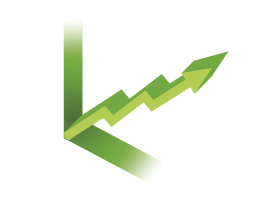 Implementation of congestion pricing on the five GO TO 2040 projects would have major economic benefits as shown in a CMAP Policy Update, including:
Implementation of congestion pricing on the five GO TO 2040 projects would have major economic benefits as shown in a CMAP Policy Update, including:
- Expanding the labor and consumer markets reachable in a 40-minute drive, for better access to airports, intermodal facilities, etc.
- Increasing gross regional product an estimated $2 billion annually.
- Increasing business output – defined as final sales by industry – about $94 billion in constant dollars from 2016 to 2040. Manufacturing, wholesaling, and transportation-related sectors would see about a quarter of this increased output, while the finance, insurance, and real estate industry sector and certain services would account for about half.
- Creating nearly 40,000 permanent new jobs within a decade after the expressways open, for total new wages of some $2.3 billion.
 Congestion pricing gives all motorists a choice they would not otherwise have, and it charges only drivers who opt to use the congestion-priced lanes. Surveys from other cities have shown that, rather than use the express toll lanes every day, drivers generally use the lanes only for two or three trips per week as needed. These findings are confirmed by CMAP's computer modeling analysis.
Congestion pricing gives all motorists a choice they would not otherwise have, and it charges only drivers who opt to use the congestion-priced lanes. Surveys from other cities have shown that, rather than use the express toll lanes every day, drivers generally use the lanes only for two or three trips per week as needed. These findings are confirmed by CMAP's computer modeling analysis. When priced appropriately, another appeal of congestion pricing is that traffic in one or two lanes always flows freely, even during rush hour. Drivers will not need to leave early as "buffer time" to avoid arriving late, freeing up that time for more worthwhile purposes. CMAP's modeling analysis shows that express lanes' travel times would be 31 to 66-percent lower than current travel times, depending on the road. Click the two graphs below for pop-up images showing travel time savings for the five GO TO 2040 congestion pricing projects.
When priced appropriately, another appeal of congestion pricing is that traffic in one or two lanes always flows freely, even during rush hour. Drivers will not need to leave early as "buffer time" to avoid arriving late, freeing up that time for more worthwhile purposes. CMAP's modeling analysis shows that express lanes' travel times would be 31 to 66-percent lower than current travel times, depending on the road. Click the two graphs below for pop-up images showing travel time savings for the five GO TO 2040 congestion pricing projects.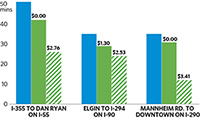
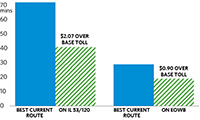
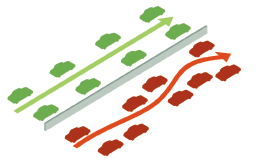 Roads with express toll lanes that are priced appropriately can actually carry more traffic than roads without congestion pricing. Up to a point, any expressway can carry more and more cars and still flow freely. However, each extra driver slows traffic down a little bit more, and as traffic slows, the volume of traffic that the expressway can carry falls. If congestion pricing can maintain free-flow speeds, an express toll lane can carry more traffic than a regular lane, which promotes the most efficient use of the road and saves everyone money over the long term.
Roads with express toll lanes that are priced appropriately can actually carry more traffic than roads without congestion pricing. Up to a point, any expressway can carry more and more cars and still flow freely. However, each extra driver slows traffic down a little bit more, and as traffic slows, the volume of traffic that the expressway can carry falls. If congestion pricing can maintain free-flow speeds, an express toll lane can carry more traffic than a regular lane, which promotes the most efficient use of the road and saves everyone money over the long term.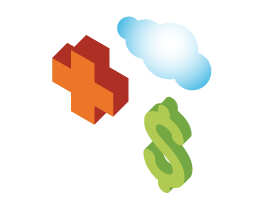 Express toll lanes can help reduce congestion's broader negative impacts on the environment, safety, and the economy. Vehicle emissions are lower when traffic is moving freely than during congested conditions. Since congestion pricing helps maintain consistent travel speeds, it also tends to improve air quality. Because crashes occur more frequently in congested conditions, congestion pricing also promotes lower accident rates. Reducing congestion helps to improve economic productivity, because commuters and commercial vehicles waste less time in traffic.
Express toll lanes can help reduce congestion's broader negative impacts on the environment, safety, and the economy. Vehicle emissions are lower when traffic is moving freely than during congested conditions. Since congestion pricing helps maintain consistent travel speeds, it also tends to improve air quality. Because crashes occur more frequently in congested conditions, congestion pricing also promotes lower accident rates. Reducing congestion helps to improve economic productivity, because commuters and commercial vehicles waste less time in traffic.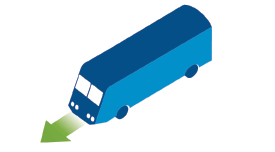 Congestion pricing provides opportunities to enhance transit service. Transit vehicles can have free access to express toll lanes, which ensure reliable travel times and fast speeds. This sort of express bus service is cheaper to provide than rail transit. With the right institutional arrangements, surplus tolling revenues could help pay for transit service.
Congestion pricing provides opportunities to enhance transit service. Transit vehicles can have free access to express toll lanes, which ensure reliable travel times and fast speeds. This sort of express bus service is cheaper to provide than rail transit. With the right institutional arrangements, surplus tolling revenues could help pay for transit service.